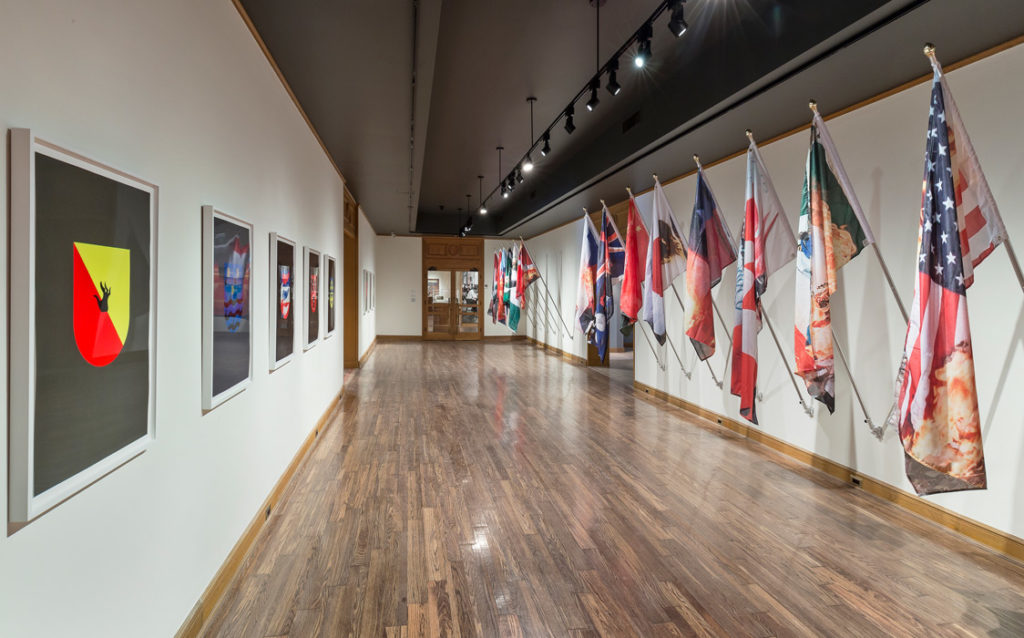In The Picture of Dorian Gray, Oscar Wilde writes, “All art is at once surface and symbol. Those who go beneath the surface do so at their peril.” Wilde would be at risk in Toronto this month. During the past two weeks, in a strange moment of symbiosis, two exhibitions with nearly identical themes opened: “Sign, sign, everywhere a sign” at the Justina M. Barnicke Gallery and the University of Toronto Art Centre, and “Signs and Symbols” at Jessica Bradley Gallery. The two exhibitions are thematically twinned, but not identical. (Although there are predictable overlaps in artists: Hadley and Maxwell and Kelly Mark make appearances in both.) While Jessica Bradley Gallery offers more installation-based and experimentally playful takes on meaning-making, “Sign, sign, everywhere a sign”—an exhibition that pulls from the university’s recent acquisitions—casts an unexpected mirror back onto the institution itself, honing its focus not on surfaces or symbols, but instead on the gallery’s role in mediating their existence. It achieves precisely what a collection exhibition should: a sense of its own function.
This edge of self-reflexivity seems surprising, if only because signs and signage offer such an expansive point of departure. But the topic’s breadth is not a mistake. Its sheer adaptability makes it useful for a collection exhibition, as these shows must tether works with little in common beyond their provenance. Unhinged from context, an exhibition about signs runs the risk of amassing information aimlessly. The result could end up feeling closer to aggregation than curation—bringing together information for the sake of it.
Distributed across two institutions, “Sign, sign, everywhere a sign” features more than 20 artists working in various mediums. Culling largely from the last couple of years of acquisitions, curator Sarah Robayo Sheridan manages, generally, to avoid tenuous inclusions (with the exception of James Carl’s Takeout (noodle), a marble sculpture of a Styrofoam container that stretches the limits of signage—the exhibition essay makes a decent enough argument for its inclusion, but it stands as an outlier). Works are brought into communion with one another, but Robayo Sheridan makes no attempt at bending them into an overarching argument.
This light curatorial touch lends itself to particular works. The humorous pieces, in particular, fare well. These are mostly located within the UTAC section of the exhibition (the noticeably stronger section of the show). Set off in a smaller room, Mark’s video Demonstration records aimless protestors out near Toronto’s waterfront, parading around with blank placards and chants of, “What do we want? Nothing.” Hadley and Maxwell’s Silly Love Songs, in the larger gallery, replicate the graphic protest posters of Atelier Populaire, created during the May 1968 student protests in Paris, but they substitute the original poster’s political urgings for the lyrics of the 1976 hit “Silly Love Songs” by Wings. Both works take well-known signs and markers and empty them out, offering a darkly deflating wit. These pieces don’t require extensive context; humour automatically relies on its own shorthand.
The wider frame of the exhibition falls short, though, with works that offer a more literal take on signage, such as Berenice Abbott’s Jacob Heymann Butcher Shop, New York City, a black-and-white photograph of a building covered in signs. Its inclusion tells more about a moment in history, when advertising became de rigueur, than Abbott’s work itself. Positioned differently, Abbott’s work would have more depth than pure documentation.
Despite the restraints of a collection exhibition, though, Robayo Sheridan manages one careful pairing in particular that moves well beyond simplistic connections. In the final room—a hallway, really—in the UTAC portion, Will Kwan’s Flame Test, a work featuring several commercially printed national flags crackling with images of flames, hangs across from General Idea’s Fear Management, a series of heraldry-inspired screenprints. Walking down the hall, surrounded by burning flags and redeployed heraldry, another collection exhibition in the next gallery comes into view: “A Story of Canadian Art: As Told by the Hart House Collection,” which features paintings by the Group of Seven. Caught between this trinity of nationalistic images, the hall casts visitors through history: from the feudal to the Modern to the present, making palpable the power that these small, ultimately arbitrary, graphics hold. It’s a deeply unsettling moment, and a welcome shot of surprising self-reflexivity. In a deluge of information, what better function can a gallery have than inspecting its role in the production and circulation of these signs?









